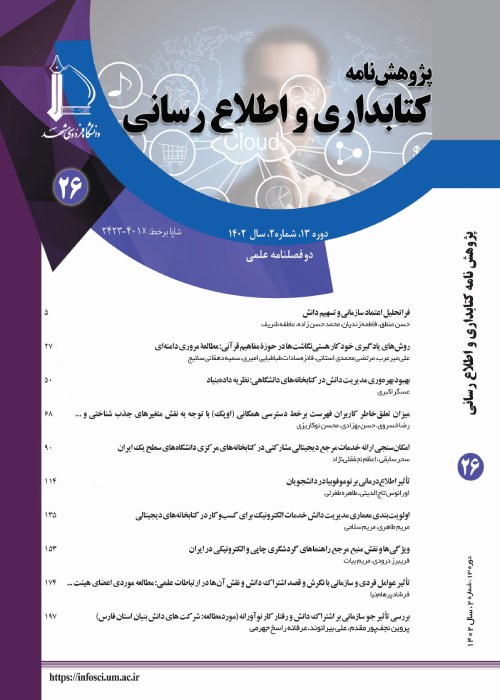Identifying the Special Types and Properties of Data Entities in the Iranian-Islamic Information Context from the Perspective of Information and Knowledge Organization
Aiming at identifying and determining the types and attributes of data entities in the Iranian-Islamic information context in order to apply them to enrich the metadata standards and schemas, the current research aims to determine the types of specific data entities in the Iranian-Islamic information context and the attributes of these data entities.
The research was considered as developmental-applied research that conducted content analysis method. The specific data entities and their attributes of the Iranian-Islamic information context were extracted with the help of using the Delphi technique and documentation method. 10 experts in the field of information and knowledge organization were selected by purposeful sampling. In the next step, metadata entities of Iranian and Islamic data entities of National Library of Iran, Astan Quds Razavi Library, Library of Quranic Culture and Knowledge Center, and Library of Islamic Promotion Office and articles of the two databases of Wikifegh and Wikishia for each type of specific attributes of specific types of extracted data entities were examined.
To realize the goal of the research, 8 specific types of data entities were identified in the Iranian-Islamic information context by conducting the documental investigations. In the next step, suitable attributes for these types were extracted. 8 special types of data entities with special features were identified in Iranian-Islamic data entities, which include the first type of Mostadrak/ Zeil/ Takmaleh/ Elhaghat; The second type of Taghrir/ Amali/ Tahrir; The third type of Description/ Explanation/ Interpretation; The fourth type of Ejazeh; The fifth type of Samaat; The sixth type of Talighat/ Comment Margins; The seventh type is Jong / Safineh / Kashkol/ Bayaz/ Moraqa/ Khergheh and finally, the eighth type is Tazkereh/ Biography/ Autobiography. In Mostadrak/ Zeil/ Takmaleh/ Elhaghat, which are written to complete another book and compensate for its shortcomings, the four main attributes were included: Type of Mostadrak, Writing Style, Structure, and Missing Part. The only main attribute "Type of Mostadrak" has three attributes at the first level. In the Taghrir/ Amali/ Tahrir, authors have discussed the basics, reasons and explanations of their teachers during the presentation of the lesson, that is, the teacher has expressed and explained something and someone else has written it, the attribute of the Type of lecture was identified. In Description/ Explanation/ Interpretation, which means explaining the conditions governing the poem or writing, two attributes including the structure of the description and the sources of the description were identified. Ejazeh, which is discussed in the field of Hadith sciences, means that authority has permitted a person to enter into the discussion of Hadith and be a narrator of Hadith. It has two attributes, types of Ejazeh and degrees of Ejazeh. Sama'ats are discussed in the field of Hadith and its content is listening to Hadiths or hearing Hadiths and it has an attribute of the level of listening. In Talighat/ Comment Margins, which are generally taken as synonyms, two main attributes were identified, including the style of writing and the validity of the margin. In Jong / Safineh / Kashkol/ Bayaz/ Moraqa/ Khergheh, which are collections of materials, especially poems which have been compiled with the taste and effort of one or more people, the attribute of the type of Jong was identified. Finally, the Tazkereh/ Biography/ Autobiography has three attributes: the type of Tazkereh, the order of the book or the method of arrangement, and the number of entries.
.In the current research, the attributes of various Iranian-Islamic data entities were identified so that these data entities can be represented and described optimally. The attributes of Iranian-Islamic data entities identified can be used to create a metadata application profile to describe and organize specific types of Iranian-Islamic information context data entities, especially in the electronic environment. Since the use of these attributes increases access points and improves accessibility to data entities, they can be used in different standards or different library software packages.
- حق عضویت دریافتی صرف حمایت از نشریات عضو و نگهداری، تکمیل و توسعه مگیران میشود.
- پرداخت حق اشتراک و دانلود مقالات اجازه بازنشر آن در سایر رسانههای چاپی و دیجیتال را به کاربر نمیدهد.




